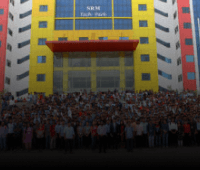
Electronic Design Automation
- Home
- Faculty of Engineering & Technology
- Center of Electronics and Skill Development and Consultancy Services
- Electronic Design Automation
Electronic Design Automation (EDA)
The electronics industry has achieved a phenomenal growth over the last few decades, mainly due to the rapid advances in large scale integration technologies and system design applications. With the advent of very large-scale integration (VLSI) designs, the number of applications of integrated circuits (ICs) in high-performance computing, controls, telecommunications, image and video processing, and consumer electronics has been rising at a very fast pace.
EDA Lab is established with the aim of conducting research process involved from wafer to chip, including device modelling and chip design to obtain the GDS file for fabrication and to establish links to meet industrial needs.
The Lab provides research facilities in the area of device modeling, simulation and various aspects of advanced VLSI design. It facilitates UG and PG students to carry out their project works on recent device modelling and circuit simulation.
Cadence Design System EDA tool is for designing full-custom integrated circuits includes schematic entry, behavioral modeling (Verilog-AMS), circuit simulation, custom layout, physical verification, extraction and back-annotation. Used mainly for analog, mixed-signal, RF, and standard-cell designs, memory and FPGA designs.
Synopsys TCAD tool is to develop and optimize semiconductor process technologies and devices. Includes process and device simulation tools, as well as a powerful graphical user interface (GUI) driven simulation environment for managing simulation tasks and analyzing simulation results. In addition, Synopsys TCAD provides tools for interconnect modeling and extraction, providing critical parasitic information for optimizing chip performance.
R&D Facilities Available For Research and Consultancy Work.
Wide variety of industry standard EDA tools are available for VLSI design and FPGA implementation
Specifications
- Cadence Design Suite (EDA Software).
- Field Programmable Analog Array (FPAA) Kit.
- Synopsys-TCAD.
- Advance Design System (ADS) – RF circuit design
- Mentor Graphics Software HEP -2 Design Verification Bundle – Questasim, PrecisionTM Synthesis, Leonardo SpectrumTM, RGQ Tracer, HDL Designer
- Xilinx Virtex-II Pro Board
- FPGA – Spartan -3 (XC3S400-4PQ208c) , Xilinx Development board with Microcontroller (XC2S150PQ208)
- Universal Trainer Base unit (FPGA – XC2S30-4TQ144, CPLD – XC9572-15pc84)
- Xilinx ISE Design Suit, HDL Editor Version 10.1
- MODELSIM 10.1b
- University Vivado System Edition
- Partial Reconfiguration License
- Zynq EPP ZC702 Evaluation Kit
MIMO TEST BED
MIMO wireless communication could be prototyped in laboratory. RF circuit design and simulation for high frequency can be carried out with ANSYS HFSS and ADS tools. Cognitive radio application for next generation wireless systems can be prototyped and measurement of performance could be executed experimentally using USRPs. Material level optical system design and analysis could be carried out with SETFOS Software.
- Vector Signal Generator & Analyzer with 2X2
- NI-USRP RIO 2943R
- NI-USRP 2901 Power Source
- Workstation
- Advanced design system (ADS) – 17.0 Version
- LabVIEW – 2014 Version
- ANSYS High Frequency Structural Stimulator
- SETFOS Version 5.2 software
- Oculus Quest 256GB,
Contact Us
Dr. J. Manjula
Associate Professor
manjulaj@srmist.edu.in
Dr. P. Vijayakumar
Professor
vijayakp@srmist.edu.in
Mr. K. Prakash
Sr. Technical Assistant
prakashk@srmist.edu.in
Mrs. N. Hemavathi
Technical Assistant
hemavatn@srmist.edu.in
















